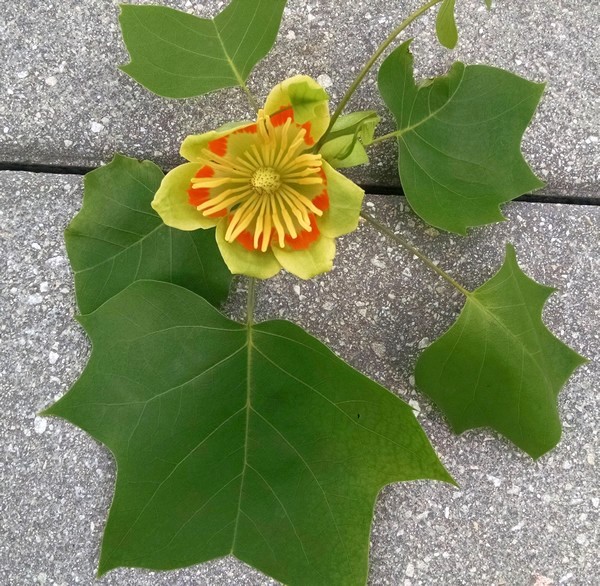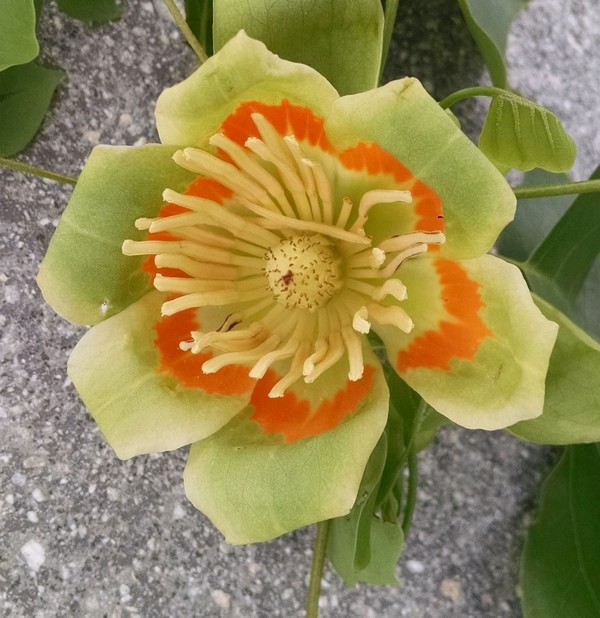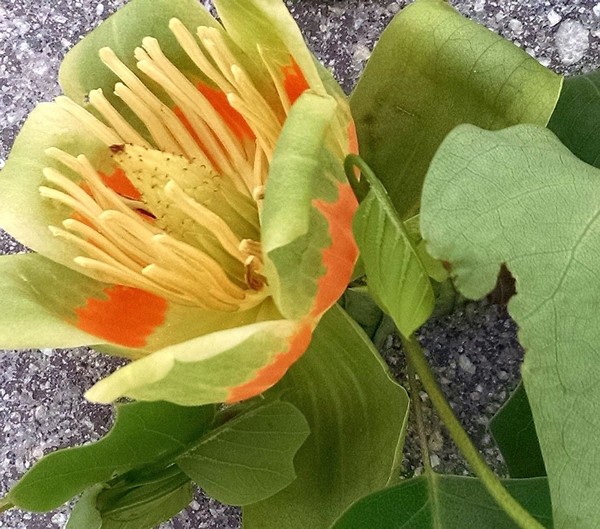
When a wind storm blew down a tuliptree branch in Oakland it gave me an opportunity to look at the flowers.
Tuliptrees (Liriodendron tulipifera) are sometimes called “tulip poplars” but they’re actually in the magnolia family. They’re one of the tallest trees in North America — up to 160 feet — and by the time they’re old enough to bloom at age fifteen they have no branches in the first 80-100 feet so we rarely see their flowers.
Like magnolias, tuliptree flowers are showy and attractive to bees — so attractive that they’re considered one of our major honey plants.
Here’s a closeup of the flower.

The petals are called “tepals” because they’re combined sepals+petals, the ancestral form of flowers.
Notice that they’re orange on both sides.

Why orange? Bees can’t see red so why do the flowers have orange accents? Are the flowers hoping for hummingbirds?
(photos by Kate St. John)
Along the rails to trails at Ohiopyle the flowers on these trees can be seen at eye level when crossing the 2nd bridge. Beautiful view of the Yough river and rapids too.
is the orange is to attract baltimore orioles?
My fave tree flower! There are a couple in Riverview Park in Tarentum. The one near the bandstand has flowers low enough to see.
I know of several large stands of mature ” tulip poplars” those flowers are very nice, and now we know very important to bees!!
Thanks Kate !
I have also observed bears climbing to the heights of these trees to eat the ” cones” ( flowers) before the bloom.
I didn’t know that bears did that, Dave. Thanks for sharing!
I’m sorry to intrude on this post with a comment about falcons, but it seemed a quick way to allow you to check a sire while the last few hours are still available. I just was checking the falcons at UMass, Amhurst, and scrolled back to see a parent eat the contents of one of the eggs. http://www.library.umass.edu/falcons/ If you look back to about 3:57 May 7, you can see it. I assume it was the mother because of the size, but I am not very familiar with those birds. There were 4 eggs initially and yesterday I noticed there were only 3. Now, 2.
Sarah Lynn, the adult is on the nest at UMass so I can’t count the chicks underneath her. Here is normal hatch time behavior: The mother peregrine to be present at hatching. She allows the chick to emerge from the shell on its own. After the chick has fully hatched, she pulls the shell away, allows the chick to dry, then broods it. While she’s brooding she eats the empty eggshell. Hope’s abnormal behavior is that (1) while the chick is hammering from inside the shell Hope picks up the egg with her beak and walks around with it and (2) Hope opens the shell, kills the chick and eats both the chick and the eggshell.
None had yet hatched. There were initially four eggs, and then I noticed three today. I saw her open the egg, although it may have pipped, pull out the hatchling,eat it, and at least some of the shell, although her back was to me by then. Then she seemed to settle down on the last two eggs. She did not seem to walk around with the egg. The scroll back is probably still good, but, of course, it’s a discouraging thing to see.
Couldn’t scroll back far enough, alas.
I was able to scroll back and she definitely ate the egg and contents. 4:02.
I don’t know how to scroll back and won’t be able to do it for 3 hours even if you told me how. Please see if you/someone can record the episode and/or capture the snapshots. This will be useful!
If you go to the UMass facebook page, they have some information:
https://www.facebook.com/umassamherstlibraries/photos/a.465299556322.247516.12436156322/10155400998201323/?type=3&theater
There is a bald eagle nest in a tulip poplar at the National Arboretum in DC. I noticed today that the flowers are starting to bud. Thanks for bringing these beautiful flowers to our attention. Before reading your post, I didn’t know this tree had flowers.
Here is a link to the webcam: http://www.dceaglecam.org/